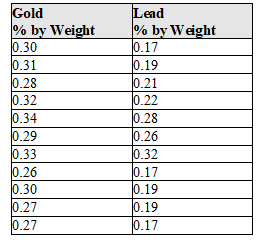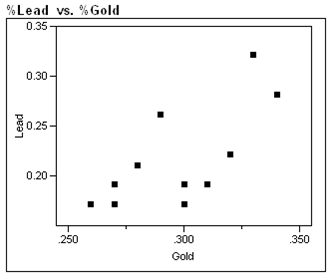Exhibit 5-5
During the first 3 centuries AD, the Roman Empire produced coins in the Eastern provinces. Some historians argue that not all these coins were produced in local mints, and further that the mint of Rome struck some of them. Because the "style" of coins is difficult to analyze, the historians would like to use metallurgical analysis as one tool to identify the source mints of these coins. Investigators studied 11 coins known to have been produced by local mints in an attempt to identify a trace element profile for these coins, and have identified gold and lead as possible factors in identifying other coins as having been locally minted. The gold and lead content, measured as a % of weight of each coin, is given in the table, and a scatter plot of these data is presented below.

-Suppose that the locally minted coins analyzed in Exhibit 5-5 are representative of the metallurgical content of mints in the Eastern provinces of the Roman Empire during the first 300 years AD.
a) If a locally minted coin is selected at random, and it's gold content is 0.30% by weight, calculate the predicted lead content. Be sure to use correct notation and units.
b) One of the coins used to calculate the regression equations has a gold content of 0.300%. Calculate the residual for this coin. Be sure to use correct notation and units.
c) The investigators would like to use the regression equation to help assess whether a coin is locally minted or minted in Rome. In a few sentences, describe how the regression equation could be used for this purpose. (Hint: In order to use the equation for this purpose, how would coins minted in Rome have to differ from locally minted coins?)
Correct Answer:
Verified
b)
c) The regression line shows h...
View Answer
Unlock this answer now
Get Access to more Verified Answers free of charge
Q26: An ice cream seller wants to predict
Q27: The data below were gathered on a
Q28: One of the problems when estimating the
Q29: The correlation coefficient between the consumption of
Q30: Assessing the goodness of fit of a
Q32: The use of small aircraft with human
Q33: An independent, or explanatory, variable is the
Q34: The Des Moines Register recently reported the
Q35: When children and adolescents are discharged from
Q36: As early as 3 years of age,
Unlock this Answer For Free Now!
View this answer and more for free by performing one of the following actions

Scan the QR code to install the App and get 2 free unlocks

Unlock quizzes for free by uploading documents